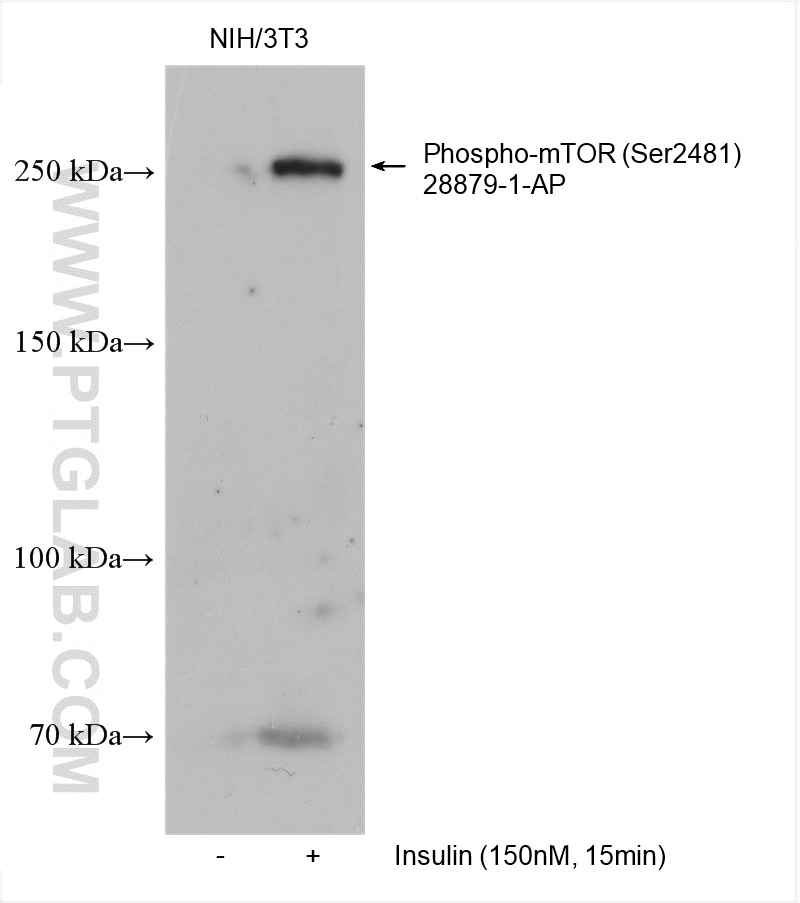Phospho-mTOR (Ser2481) Polyklonaler Antikörper
Phospho-mTOR (Ser2481) Polyklonal Antikörper für WB, ELISA
Wirt / Isotyp
Kaninchen / IgG
Getestete Reaktivität
Maus und mehr (2)
Anwendung
WB, ELISA
Konjugation
Unkonjugiert
Kat-Nr. : 28879-1-AP
Synonyme
Geprüfte Anwendungen
| Erfolgreiche Detektion in WB | mit Insulin behandelte NIH/3T3-Zellen |
Empfohlene Verdünnung
| Anwendung | Verdünnung |
|---|---|
| Western Blot (WB) | WB : 1:500-1:1000 |
| It is recommended that this reagent should be titrated in each testing system to obtain optimal results. | |
| Sample-dependent, check data in validation data gallery | |
Veröffentlichte Anwendungen
| WB | See 11 publications below |
Produktinformation
28879-1-AP bindet in WB, ELISA Phospho-mTOR (Ser2481) und zeigt Reaktivität mit Maus
| Getestete Reaktivität | Maus |
| In Publikationen genannte Reaktivität | human, Maus, Ratte |
| Wirt / Isotyp | Kaninchen / IgG |
| Klonalität | Polyklonal |
| Typ | Antikörper |
| Immunogen | Peptid |
| Vollständiger Name | FK506 binding protein 12-rapamycin associated protein 1 |
| Berechnetes Molekulargewicht | 289 kDa |
| Beobachtetes Molekulargewicht | 250-289 kDa |
| GenBank-Zugangsnummer | BC117166 |
| Gene symbol | mTOR |
| Gene ID (NCBI) | 2475 |
| Konjugation | Unkonjugiert |
| Form | Liquid |
| Reinigungsmethode | Antigen-Affinitätsreinigung |
| Lagerungspuffer | PBS with 0.02% sodium azide and 50% glycerol |
| Lagerungsbedingungen | Bei -20°C lagern. Nach dem Versand ein Jahr lang stabil Aliquotieren ist bei -20oC Lagerung nicht notwendig. 20ul Größen enthalten 0,1% BSA. |
Hintergrundinformationen
MTOR, also named FRAP1, FRAP, FRAP2, and RAPT1, belongs to the PI3/PI4-kinase family. MTOR is a Ser/Thr protein kinase that functions as an ATP and amino acid sensor to balance nutrient availability and cell growth. MTOR is the kinase subunit of both mTORC1 and mTORC2, which regulate cell growth and survival in response to nutrient and hormonal signals. mTORC1 is activated in response to growth factors or amino acids. mTORC2 is also activated by growth factors but seems to be nutrient-insensitive. mTORC2 seems to function upstream of Rho GTPases to regulate the actin cytoskeleton, probably by activating one or more Rho-type guanine nucleotide exchange factors. mTORC2 promotes the serum-induced formation of stress fibers or F-actin. mTOR is phosphorylated at Ser2448 via the PI3 kinase/Akt signaling pathway and autophosphorylated at Ser2481. mTOR plays a key role in cell growth and homeostasis and may be abnormally regulated in tumors.
Protokolle
| PRODUKTSPEZIFISCHE PROTOKOLLE | |
|---|---|
| WB protocol for Phospho-mTOR (Ser2481) antibody 28879-1-AP | Protokoll herunterladen |
| STANDARD-PROTOKOLLE | |
|---|---|
| Klicken Sie hier, um unsere Standardprotokolle anzuzeigen |
Publikationen
| Species | Application | Title |
|---|---|---|
Anal Cell Pathol (Amst) Shikonin Induces Autophagy and Apoptosis in Esophageal Cancer EC9706 Cells by Regulating the AMPK/mTOR/ULK Axis | ||
Am J Transl Res Integrating network pharmacology with experimental validation to investigate the mechanism of Wuwei Zishen formula in improving perimenopausal syndrome | ||
Naunyn Schmiedebergs Arch Pharmacol Network pharmacology-based strategy to reveal the mechanism of pinocembrin against ovarian cancer | ||
Sci Rep Morphine promotes non-small cell lung cancer progression by downregulating E-cadherin via the PI3K/AKT/mTOR pathway | ||
Int J Biol Macromol Lactoferrin ameliorates cognitive impairment in D-galactose-induced aging mice by regulating the PI3K/Akt/mTOR signaling pathway and the microbiome-gut-brain axis | ||
Eur J Neurosci Oleracein E Rejuvenates Senescent Hippocampal NSCs by Inhibiting the ERK1/2-mTOR Axis to Improve Cognitive Dysfunction in Vascular Dementia |


